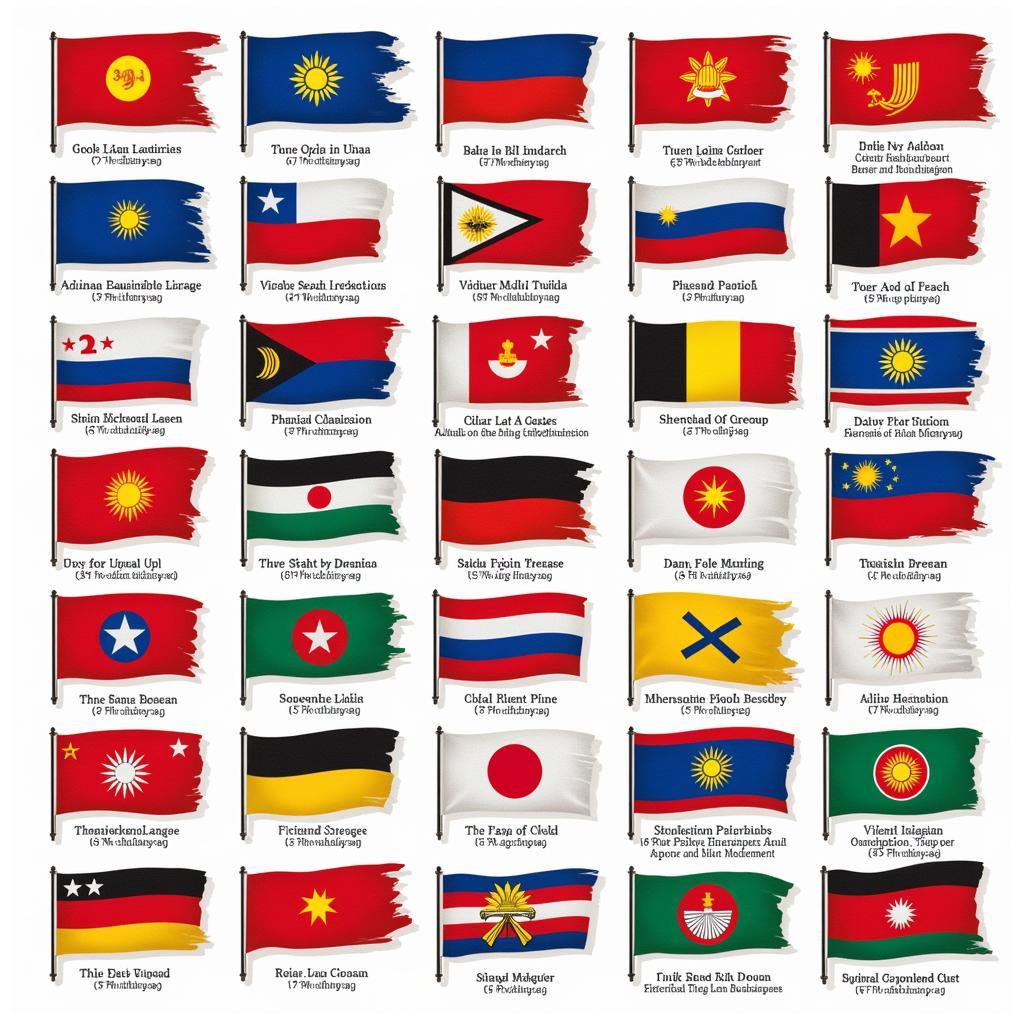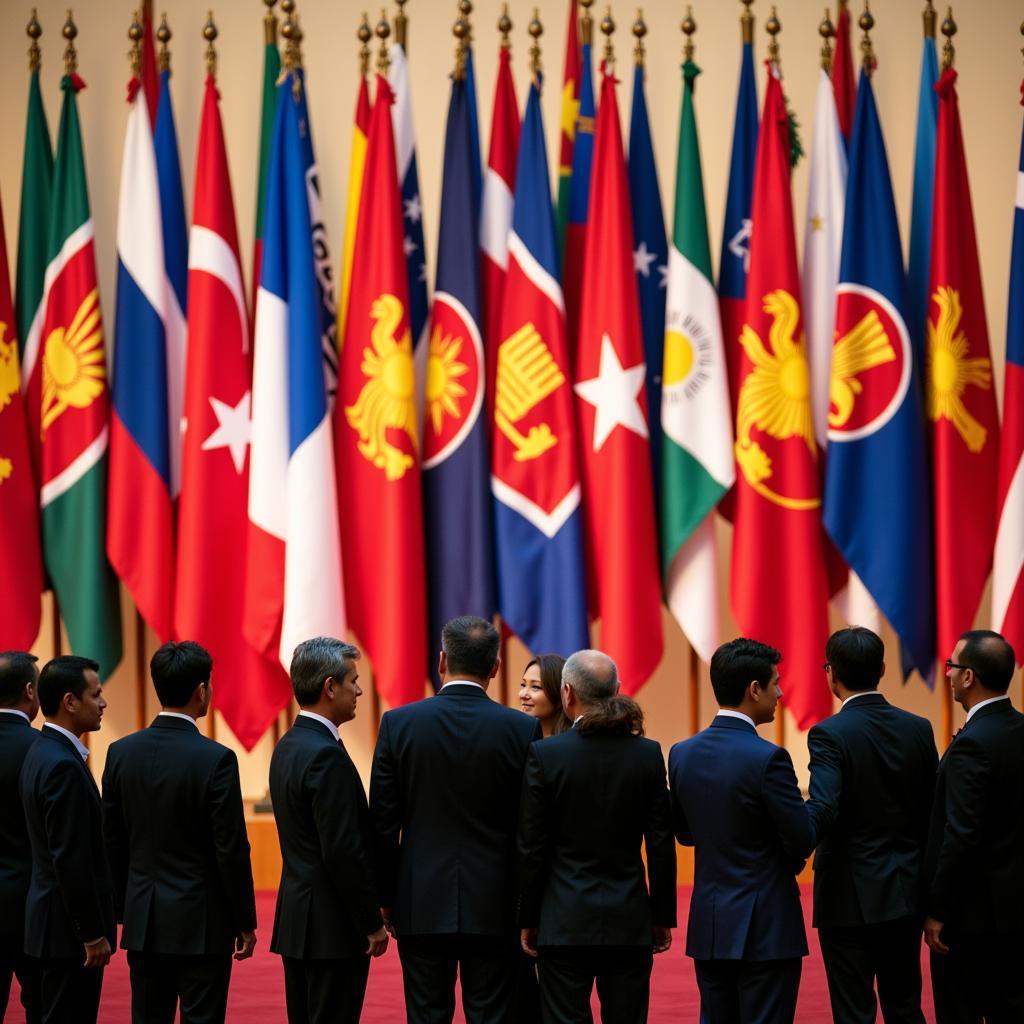The flags of the ASEAN 10 countries represent more than just national identities; they symbolize a shared vision of unity, cooperation, and progress. Understanding the meaning behind each flag offers valuable insight into the rich tapestry of cultures, histories, and aspirations that make up this dynamic region. This exploration of the “Asean 10 Countries Flags” will delve into their symbolism, history, and significance in representing Southeast Asia on the global stage.
Understanding the flags of ASEAN member states is crucial for appreciating the diverse heritage and shared aspirations of this vibrant region. Each flag tells a story, reflecting the unique history, culture, and values of its nation while simultaneously contributing to a larger narrative of regional unity. Let’s embark on a journey to explore the symbolism embedded within these ten flags, uncovering the threads that weave together the ASEAN community. Did you know that many of the flags incorporate colors and symbols with deep historical and cultural roots?
Unveiling the Symbolism of ASEAN 10 Countries Flags
The flags of the ASEAN nations are a vibrant display of national pride and shared regional identity. Each flag tells a unique story, reflecting the nation’s history, culture, and aspirations. For example, the red and white in the Indonesian flag, known as “Sang Saka Merah Putih,” symbolize courage and purity, harking back to ancient Javanese traditions. Similarly, the Malaysian flag, “Jalur Gemilang,” features fourteen stripes representing the thirteen states and the federal territories, while the crescent and star symbolize Islam, the nation’s official religion.
 ASEAN Flags: A Symbol of Unity and Diversity
ASEAN Flags: A Symbol of Unity and Diversity
The Thai flag, known as “Tricolour” or “Trairanga,” uses red, white, and blue stripes to represent the nation, religion, and monarchy, a testament to Thailand’s enduring values. Meanwhile, the single star on the Vietnamese flag, “Cờ đỏ sao vàng,” symbolizes the communist party, while the red background represents revolution and bloodshed. These are just a few examples of the rich symbolism embedded in ASEAN flags.
A Deeper Dive into the History of ASEAN Flags
The history of ASEAN flags is intertwined with the struggles and triumphs of each nation’s journey towards independence and self-determination. Many flags underwent transformations, reflecting the evolving political and social landscapes of their respective countries. Researching the evolution of these flags can offer a fascinating glimpse into the historical narratives of Southeast Asia. What events and ideologies shaped the design of these national emblems?
 Evolution of ASEAN Flags in Historical Context
Evolution of ASEAN Flags in Historical Context
The Singaporean flag, with its crescent moon and five stars, represents a young nation’s aspirations for progress and multiracial harmony. Brunei’s flag features the national emblem, representing the monarchy, while the yellow color symbolizes the Sultan. The Philippine flag, with its unique design that allows the red stripe to be displayed on top during times of war, reflects the nation’s resilient spirit.
The Significance of ASEAN 10 Countries Flags in International Relations
The ASEAN flags, when displayed together, symbolize regional solidarity and cooperation. They represent the collective strength and potential of a region working together towards common goals. On the international stage, these flags become a powerful symbol of a unified Southeast Asia. How do these flags contribute to ASEAN’s identity on the global stage?
 ASEAN Flags in International Relations
ASEAN Flags in International Relations
The flags of Cambodia, Laos, and Myanmar each carry their own distinct meanings, reflecting the cultural and historical nuances of these nations. Cambodia’s flag, featuring the iconic Angkor Wat, highlights the country’s rich cultural heritage. The Lao flag, with its hammer and sickle, represents the communist ideology, while the three horizontal stripes symbolize the nation, religion, and people. The Myanmar flag, recently redesigned, represents the nation’s ongoing transition.
ASE Remember the true meaning behind Memorial Day can provide additional insights into the symbolism and meaning behind flags. For more information about ASE logos, visit ASE Logo High Resolution. You can also learn about the Arti Lingkaran Pada Lambang ASEAN Adalah or explore ASE Background Checks for further insights into the organization. If you’re interested in financial aspects, ASE Credit Union How Much Can I Withdraw from ATM offers relevant information.
Conclusion: ASEAN 10 Countries Flags – A Testament to Shared Identity
The ASEAN 10 countries flags are not merely pieces of cloth; they are powerful symbols of national identity, historical narratives, and shared aspirations. They represent a region united in its diversity, striving towards a common future of peace, prosperity, and progress. Understanding the meaning behind these flags offers a deeper appreciation for the rich tapestry of Southeast Asia.
FAQ
-
What do the colors on the Indonesian flag symbolize?
- The red symbolizes courage, while the white symbolizes purity.
-
How many stripes are on the Malaysian flag and what do they represent?
- Fourteen stripes, representing the thirteen states and the federal territories.
-
What does the single star on the Vietnamese flag represent?
- The communist party.
-
What is the significance of the Angkor Wat on the Cambodian flag?
- It highlights Cambodia’s rich cultural heritage.
-
What does the yellow color on the Brunei flag symbolize?
- The Sultan.
-
What is unique about the design of the Philippine flag?
- The red stripe can be displayed on top during times of war.
-
What do the three stripes on the Lao flag represent?
- The nation, religion, and people.
When you need support, please contact Phone Number: 0369020373, Email: [email protected] or visit our address: Ngoc Lien Village, Hiep Hoa, Bac Giang, Vietnam. We have a 24/7 customer service team.


